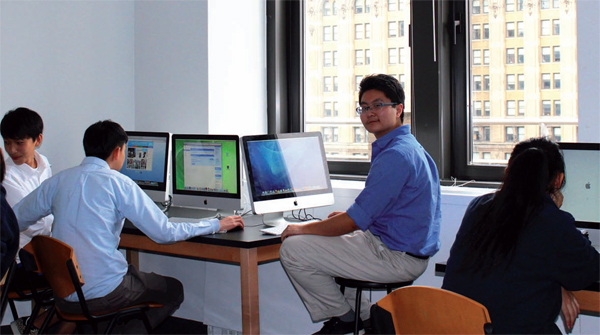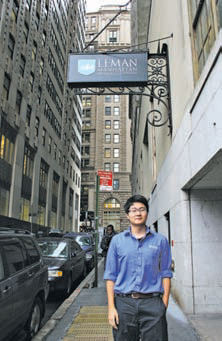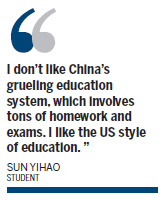Prep schools give Chinese kids an edge
Updated: 2012-11-16 14:21
By YU WEI in New York (China Daily)
|
||||||||
Dozens of teenage boys and girls wearing the business-casual uniform of an elite Manhattan prep school rush into the cafeteria on a recent afternoon, boisterous conversations all around.
It's an unremarkable scene that could play out at any private institution tasked with educating the children of well-to-do Americans.
But these students are Chinese, which becomes evident even from afar since their chatting is exclusively in Mandarin.
 |
|
Sun Yihao, here in a classroom at Manhattan's Léman school, is confident his US academic experience will prepare him for admission to Princeton University, where he hopes to study finance. YU WEI / CHINA DAILY |
They're enrolled at Léman Manhattan Preparatory School, in New York's financial district.
Among the group is Sun Yihao, a 17-year-old from Shanghai who is a junior in Léman's high school (there also are lower- and middle-school programs). Léman is good preparation for studying at a US university, said Sun, who dreams of being admitted to Princeton after his high-school graduation.
"I don't like China's grueling education system, which involves tons of homework and exams. I like the US style of education," he said.
Sun and his classmates are part of a rapidly accelerating trend. According to the US Department of Homeland Security, only 65 Chinese students were enrolled in private American high schools during the 2005-2006 academic year. By 2010-2011, the number reached 6,725, an explosion of 10,000 percent.
"The location is great; I think it will be good for my future," Sun said in a classroom just blocks from Wall Street itself and landmarks such as the New York Stock Exchange and the bronze Charging Bull sculpture. He hopes to major in finance at Princeton.
Most of the other Chinese at Léman also plan to go on to US colleges and universities, said Sun.
Those institutions have seen Chinese enrollment from China rise 23 percent this year, to 190,000, or a quarter of all of their international students, according to Open Doors, published annually by the Institute of International Education and the US State Department.
 |
|
Sun Yihao stands in front of Léman’s entrance in downtown Manhattan. YU WEI / CHINA DAILY |
Léman's 40 international boarders live in a school-run dormitory at 37 Wall St, a luxury building anchored by jeweler Tiffany & Co on the ground floor.
Their education experience isn't cheap. The cost for an international student who boards at Léman is $68,000 a year including tuition.
"Compared to my high school in China, the cost is high. But my parents are 100 percent supportive," said Sun, who previously attended a private Shanghai school whose annual tuition of 110,000 yuan ($17,500) was far more expensive than a Chinese public high school.
On average, the total cost (tuition plus room and board) of attending a private boarding school in the New York metropolitan area is $46,875 for the 2011-2012 academic year, according to the National Association of Independent Schools. That's about $2,000 above the median cost per year for all US private boarding schools.
"It's expensive, but when you live on Wall Street, the cost of apartments and the cost of living are huge," said Drew Alexander, head of school at Léman, which opened its doors in 2005.
With teenagers, many of them from other countries, in its charge amid the concrete canyons of lower Manhattan, the school has a number of safety measures in place. For one, students must have their school-assigned mobile phone with them when they sign out, and they are allowed to leave their dorm only in groups of three or more.
To earn the freedom to explore their immediate environs, Léman students must pass a series of tests — take a walking tour of the neighborhood, demonstrate a working knowledge of the New York City transit system and attend a safety presentation by the police department.
This year, 30 of Léman's international boarding students are Chinese; the other 10 are from Italy, Russia, Germany, South Korea and Turkey.
For Sun, the prevalence of so many compatriots can be frustrating.
"I can't practice my English well enough when there are so many Chinese classmates around," he complains.
To address this, the school has established an English-as-a-secondlanguage, or ESL, program that extends beyond regular classroom hours.
"In reality, students spend most of their day in an English context — taking classes in English, socializing with American students, doing homework in English," said Brylee Maxfield, communications manager at Léman.
She points out that New York's diversity provides students many opportunities to step outside their comfort zone and experience many other languages and cultures.
Besides its extended ESL services, the school also provides at least one Mandarin-speaking instructor to translate for Chinese students when they're struggling to understand something in class.
According to the Association of Boarding Schools, about 5,600 students from China enrolled in its 285 member schools in the US this academic year. On average, each school has about 20 Chinese students, a number that has increased steadily for nearly a decade.
"Having many students from a single country or language group can be challenging," said Pete Upham, executive director of the North Carolina-based association, which also represents schools in Canada and other countries.
"Families from China or any country are sending their kids to US boarding schools in part to have a Western experience," he said. "If there are a large number of students from their home country, it begins to take the shine of the appeal of these places."
The Chinese student body at US boarding schools appears to be nearing a plateau, Upham said.
|
 |
"I do expect that next year there still will be more Chinese students, but I think the rate of growth is slowing considerably."
The reason isn't demand, which remains high. Instead, schools are nearly at capacity for absorbing all the Chinese students they can, given their desire to have a diverse student population.
Many US boarding schools are nonetheless putting more resources into recruiting from China.
Administrators at Squaw Valley Academy, on the California (western) side of Lake Tahoe, recently visited Chinese high schools to promote their institution, which caters to foreign as well as American students.
According to Squaw Valley admissions director Adrienne Forbes, the school has received many applications from China since it began enrolling Chinese students in 2006.
To better serve this growing population, the California school now o+ers meals each week that are Chinese- inspired and organizes Chinese cultural activities every Friday.
"The students enjoy a Chinese dinner, play games of mahjong and watch Chinese videos," Forbes said. "We offer many opportunities for our Chinese students to have a shared cultural experience with their Chinese friends and with students from all nations on campus."
yuwei12@chinadailyusa.com

 Relief reaches isolated village
Relief reaches isolated village
 Rainfall poses new threats to quake-hit region
Rainfall poses new threats to quake-hit region
 Funerals begin for Boston bombing victims
Funerals begin for Boston bombing victims
 Quake takeaway from China's Air Force
Quake takeaway from China's Air Force
 Obama celebrates young inventors at science fair
Obama celebrates young inventors at science fair
 Earth Day marked around the world
Earth Day marked around the world
 Volunteer team helping students find sense of normalcy
Volunteer team helping students find sense of normalcy
 Ethnic groups quick to join rescue efforts
Ethnic groups quick to join rescue efforts
Most Viewed
Editor's Picks

|

|

|

|

|

|
Today's Top News
Health new priority for quake zone
Xi meets US top military officer
Japan's boats driven out of Diaoyu
China mulls online shopping legislation
Bird flu death toll rises to 22
Putin appoints new ambassador to China
Japanese ships blocked from Diaoyu Islands
Inspired by Guan, more Chinese pick up golf
US Weekly

|

|






